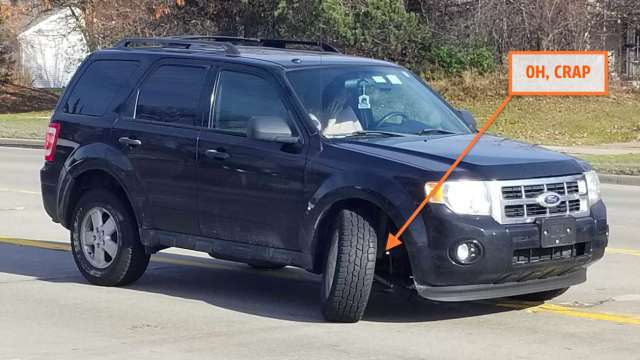A few weeks ago, while driving to pick up a battery for my recently-drowned 1948 Jeep, I noticed a black second-generation Ford Escape curiously sitting in the road, straddling two lanes. One of the wheels was cocked hard to the right with lots of camber, and it didn’t take me long to realise what had likely happened: ball joint failure. This kind of scene has become all too common where I live, which is why I’m here to tell you that ignoring that little “shimmy” in your car’s steering is just not worth it.
I won’t get into why I think an extremely basic vehicle inspection should be mandatory, because I’ve already done that, and, as others have pointed out, it would probably never work. Vehicle inspections are a slippery slope, you see, and the likelihood of a state sticking to the idea of checking only “silent killers” is pretty low.
“Silent killers,” as I described in my previous story, are vehicle failure modes that are difficult to predict in that the compromised parts are hard to inspect, and they don’t provide much warning before failing catastrophically. Rusty brake lines are an important one, since most folks don’t like crawling under their vehicles, and when a hard line ruptures, it can render brakes in that circuit completely useless.
Then there are the ball joints, parts that I frequently preach should never be neglected. If you drive a normal car, your car has a knuckle, which is a big metal casting that holds the wheel on via a wheel hub. The wheel hub is what has the studs you thread your lug nuts onto. The ball joint’s job is to allow the knuckle to rotate to allow for steering. In other words, it keeps the wheel attached to the car. Ball joints are generally found only on the front of a vehicle, and over time, they do wear out.
That’s what I’m fairly certain happened to the Ford Escape seen above. Notice how the wheel yanked the axle shaft right out of the transaxle. Clearly, a part of the suspension that normally constrains wheel motion and prevents the axle from over-extending, has failed. And while that part could have been a tie rod (which connects the wheel’s steering angle with that of the steering wheel) or a rusted-out lower control arm, I bet it was a bad lower ball joint.
A ball joint is just a ball inside of a grease-filled socket, and, especially if the grease is contaminated, that socket just wears down and… Escapes. This isn’t a “sudden” failure like a bad brake line, but the warning signs can be subtle.
The symptoms are usually a vibration in the steering and eventually some banging from the wheel well, but those aren’t always as dramatic as they should be considering the seriousness of the potential looming failure. I know this, because I experienced it with my shitty old 1995 Honda Accord, whose ball joint—as shown above—was on the verge of busting out of its socket. God I hated that car.
When the ball does escape from the socket, the best case scenario is what apparently happened to the Escape driver. While the vehicle is driving slowly, the wheel wobbles all over the place and gets shoved into the wheel well, making all sorts of banging sounds and slowing the vehicle down. A less-pleasant case, though, is the wheel leaning in the other direction:
That’s what happened to a reader named Alex, who showed me these photos after offering his heated garage as a place for me to wrench on my new $US700 ($1,025) “Holy Grail” Jeep Grand Cherokee in Colorado.
He described what happened when the 2011 Ford F-150’s upper ball joint (Note: The Escape’s strut-type suspension has only a lower ball joint, not an upper) suddenly let go while driving down a muddy, steep hill. “The wheel rotated out 90 degrees, tore out the ball on the lower control arm,” he wrote, “and the truck skidded to a stop with the lower control arm sitting on top of the wheel.”
“The truck sat out for a week while we waited for the snow to melt off and dry off enough to get to it,” he said of what seemed like a terrible experience. But he was able to get the vehicle back on the road. “We pulled the half shaft, field replaced the [upper control arm], ball on the [lower control arm], and brake line,” he continued, “then drove the thing out in 2wd low chained up.”
Damn that’s a nasty failure.
But I see stuff like this regularly on freeways in the Detroit metropolitan area. Ball joint, tie rod end, whatever—people keep driving their vehicles despite the banging noise coming from the suspension, and eventually, the ball joint or tie rod end gives out, and the car loses steering. Often times, the cars sitting in the road look like the photo above, with the wheel laying on its side and suspension guts on display.
Don’t let this happen to you. Inspect your car’s suspension and steering, especially if you hear a banging noise or feel vibrations in your steering. Here’s how you can do that yourself.
